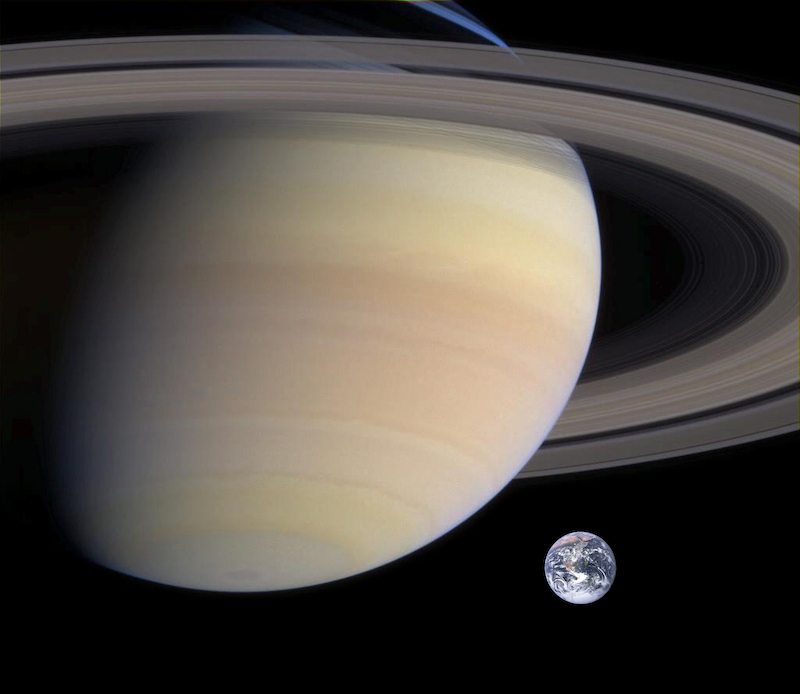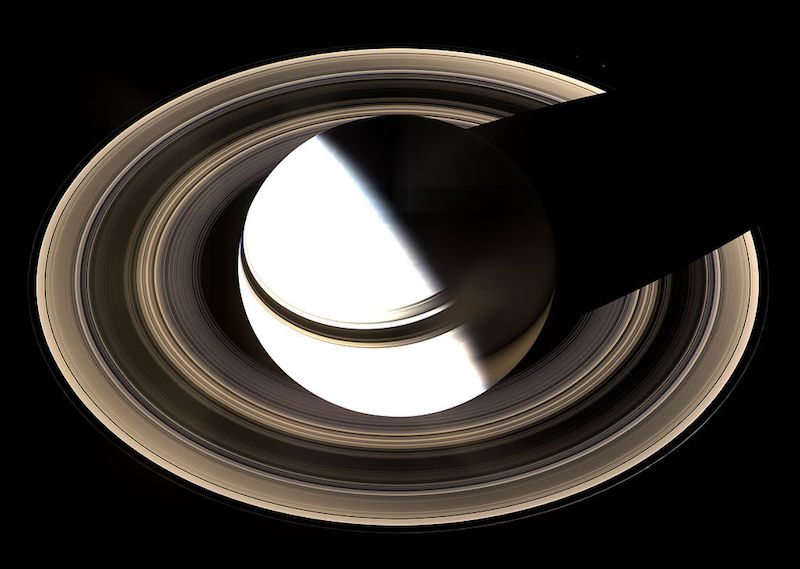Saturn
Episode #6 of the course Introduction to the Solar System
As the sixth planet from the Sun, Saturn is one of five planets visible to the naked eye. Composed of gases, Saturn is most famous for the beautiful rings that circle its equator and for the 62 moons that orbit it.
The gigantic size of Saturn is 764 times larger than Earth. After Jupiter, Saturn is the second largest planet in our solar system and measures 75,000 miles (120,000 km) in diameter. That’s nine times wider than Earth. Although it is the solar system’s second largest planet, it lacks the necessary mass to undergo the fusion needed to power a star. As the sixth planet from the Sun, Saturn can be anywhere from 840 to 930 million miles (1.35-1.5 billion km) from the center of our solar system.

Size comparison of Saturn and Earth
Saturn is one of four planets composed of gas, and as such, it doesn’t truly have a “surface” on which to land. Approximately 96% of the planet’s composition is hydrogen, and the remaining 4% is primarily helium, though there are also traces of ice containing ammonia, methane, and water. Scientists theorize that the planet does have a solid core, but they are uncertain how big it is or what chemical composition they would find there.
Saturn’s rings are composed primarily of bits of ice pulled together by the planet’s gravitational forces. When light hits these particles, brilliant colors are emitted and result in spectacular satellite images. Scientists count seven layers of rings and have classified them as A-G, in order of discovery.

The rings of Saturn (imaged here by Cassini in 2007) are the most massive and conspicuous in the Solar System
Saturn is surrounded by 62 moons (according to NASA’s official records) in a wide range of sizes and shapes, from spherical and cylindrical to saucer-shaped and misshapen. Each moon is named after gods and mythological characters. The largest moon is Titan, which is bigger than Mercury or Pluto, and the smallest moon is Mimas, which is small enough to fit into the state of Texas. Given Titan’s earth-like terrain, two unmanned missions have ventured to the moon to study it further. Saturn’s brightest moon is named Enceladus, a relatively small celestial body with a white, icy surface that has earned the distinction of the brightest object in our solar system.

A montage of Saturn and its principal moons (Dione, Tethys, Mimas, Enceladus, Rhea and Titan; Iapetus not shown). This famous image was created from photographs taken in November 1980 by the Voyager 1 spacecraft
Saturn is also distinctive because of the somewhat strange behavior of its North Pole, given that it is surrounded by a hexagon that stretches nearly 20,000 miles (32,000 km). Stormy winds swirl around the pole and travel at approximately 200 miles (320 km) per hour.

North polar hexagon and vortex as well as rings (2 April 2014)
On certain nights—and thanks to Saturn’s remarkable size—the ringed planet is visible to the naked eye. As a result, Saturn has been known to exist for thousands of years and is named after the Roman god of farming. In 1610, Galileo peered through his telescope and saw Saturn’s rings, but it wasn’t until 1655 that astronomer Christiaan Huygens discovered what they were.
Recommended book
Share with friends

